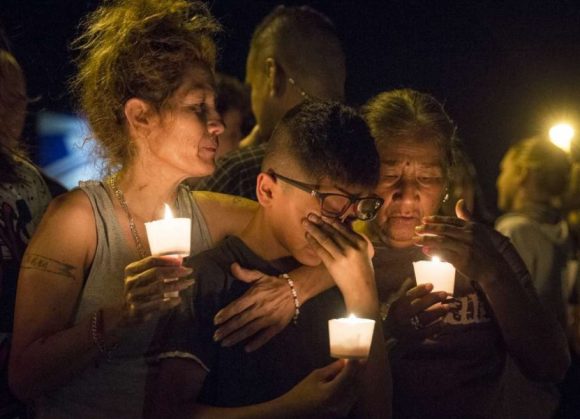
Dear Commons Community,
Reuters and other news media are reporting that at 11:30 yesterday morning, a gunman killed at least 26 worshipers and wounded 20 others in the First Baptist Church in Sutherland Springs, Texas, about 40 miles east of San Antonio. The gunman, Devin P. Kelley, a white man, was found dead in his car a little while later. As reported by Reuters.
——————————-
SUTHERLAND SPRINGS, Texas, Nov 5 (Reuters) – A gunman massacred at least 26 worshipers and wounded 20 others at a white-steepled church in southeast Texas on Sunday, carrying out the latest in a series of mass shootings that have plagued the United States, authorities said.
The lone suspect, wearing black tactical gear and a ballistic vest and carrying an assault rifle, opened fire after entering the First Baptist Church in Sutherland Springs in Wilson County, about 40 miles (65 km) east of San Antonio.
The victims ranged in age from 5 to 72 years old, law enforcement officials said at a news conference.
After the shooting, the gunman, described as a white man in his 20s, was fired on by a local resident. He fled in his vehicle and was later found dead in neighboring Guadalupe County.
It was not immediately clear if the suspect killed himself or he was hit by gunfire by the resident, authorities said.
“We are dealing with the largest mass shooting in our state’s history,” Texas Governor Greg Abbott said at the news conference. “The tragedy of course is worsened by the fact that it occurred in a church, a place of worship where these people were innocently gunned down.”
Neither the suspect’s identity nor motive were disclosed by authorities.
But law enforcement officials who were not identified have said the gunman was Devin P. Kelley, describe as a white, 26-year-old man, the New York Times and other media reported.
The 14-year-old daughter of pastor Frank Pomeroy was killed, the family told several television stations.
Jeff Forrest, a 36-year-old military veteran who lives a block away from the church, said what sounded like high-caliber, semi-automatic gunfire triggered memories of his four combat deployments with the Marine Corps.
“I was on the porch, I heard 10 rounds go off and then my ears just started ringing,” Forrest said. “I hit the deck and I just lay there.”
The massacre comes just weeks after a sniper killed 58 people at an outdoor concert in Las Vegas, the deadliest mass shooting in modern U.S. history. The shootings have stirred a years-long national debate over whether easy access to firearms was contributing to the trend.
President Donald Trump said he was monitoring the situation while in Japan on a 12-day Asian trip.
“May God be w/ the people of Sutherland Springs, Texas. The FBI & law enforcement are on the scene,” he said on Twitter.
According to the witnesses, about 20 shots rang out at 11:30 a.m. (1730 GMT) during the church services, according to media reports. It was unclear how many worshippers were inside at the time.
After the shooting, the suspect sped away in a car and was soon cornered by sheriff’s deputies just outside of Wilson County in Guadalupe County, Wiley told Reuters. He did not know if the shooter died of a self-inflicted gunshot or was killed by deputies.
Connally Memorial Medical Center in Floresville received eight patients, the hospital said in a statement, while Brooke Army Medical Center at Fort Sam Houston received another eight.
At Connally, three people were treated and released, one is in critical condition and four were transferred to the University Hospital in San Antonio for a higher level of care.
The First Baptist Church is one of two houses of worship in Sutherland Springs, an area that is home to fewer than 900 residents, according to the 2010 Census. There are also two gas stations and a Dollar General store in town.
The white-painted, one-story structure features a small steeple and a single front door. On Sunday, the Lone Star flag of Texas was flying alongside the U.S. flag and a third, unidentified banner.
Inside there is a small raised platform on which members sang worship songs to guitar music and the pastor delivered a weekly sermon, according to videos posted on YouTube. In one of the clips, a few dozen people, including young children, can be seen sitting in the wooden pews.
The shooting occurred on the eighth anniversary of the Nov. 5, 2009, massacre of 13 people at the Fort Hood Army base in central Texas. A U.S. Army Medical Corps psychiatrist convicted of the killings is now awaiting execution.”
This is all so sad. We grieve with the family and friends of the victims!
Tony











